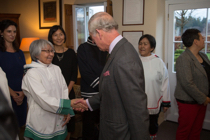Revitalizing Inuktitut for the 21st Century, a lesson from the Welsh
December 2016
This time last year Sarah Townley of North West River would never have guessed that she would be visiting Prince Charles in his castle in Wales - but on December 10th Townley and 16 other Canadian Inuit traveled to Wales to learn about how the Welsh are revitalizing their language.
Townley works as an Inuktitut language instructor with the Nunatsiavut Inuit Bachelor of Education program which is training Labrador Inuit teachers. The Prince's Charities of Canada invited Townley and 16 other Inuit from across Canada to Wales for one week there to tour the country and speak with those responsible for revitalizing and modernizing the Welsh language - including Prince Charles. The Prince of Wales has himself been working to learn the Welsh language.
“We had several opportunities to learn about Welsh in the education system, the experiences and the stories of the Welsh on language roll out. They rolled out a pipeline of fluent Welsh speakers who could teach the language, write in the language and publish material,” explains Townley. “We’ll be meeting with the Welsh Council and this will give us an opportunity to learn and discuss various aspects of the publishing industry and how it’s developed in Wales.”
Representing Labrador Inuit, Townley and other language experts from across the Inuit Nunangat make up Inuit Tapiriit Kanatami’s Atausiq Inuktitut Titirausiq (AIT) Task Group. Since 2013 the task group has been examining how to develop a unified Inuktitut writing system. Right now there are many different dialects across the four Inuit homelands in Canada, and with these different dialects comes different ways of writing the language. These writing systems vary from region to region with some in syllabics and some in the Latin alphabet.
The Welsh have worked hard to preserve their language which emerged in Great Britain over 1500 years ago. The language was on the decline, being replaced by English but efforts to modernize the language for the internet and smartphones has really paid off. It is this kind of forward thinking and ingenuity that Inuit are hoping to bring back to the Nunangat.
“The visit to Wales started with a meeting at the language technology unit at Bangor University,” says Townley, “This visit provided a chance to learn from the individuals responsible for the terminology standardization projects, and also to meet with those responsible for developing IT tools for the Welsh language.”
The Welsh people have done a number of interesting technology-driven language initiatives, such as creating a Welsh version of the Windows operating system, Welsh dictionaries for Microsoft Word, a Welsh Wikipedia, predictive texting dictionaries for smart phones, Facebook in the Welsh language and many more projects.
Representatives from the Maori People of New Zealand will also be joining the AIT Task Group in Wales. They will be talking about their efforts to revitalize the Maori language, which has been one of the official languages of New Zealand since 1987.
“We’ve heard about the Greenland [language revitalization] experience, and the Alaska [language revitalization] experience,” says Townley, “but this was our first time hearing about other cultures’ language revitalization.”
The AIT task group brought a number of presents and cultural items with them to Wales, but Townley is delighted with one gift in particular. “We brought Inuit tea from Nunavik,” says Townley with a laugh, “we thought it would be the perfect gift to bring to the UK.”
Now that they are back in Canada the Task Group will take their findings to the ITK board of directors, and together they will determine what will work best in the Inuit Nunangat.
“The task group will make recommendations to ITK board of directors, and if they adopt the recommendations or approve them, then our real work starts,” says Townley. “We’ll be doing things like developing resource materials and develop training programs to teach the new writing system, writing dictionaries to implement the new writing system.”
Over the coming weeks and months the Atausiq Inuktitut Titirausiq Task Group will determine which best practices from abroad they can use in the unification and modernization of the Inuktitut language for the 21st Century.





